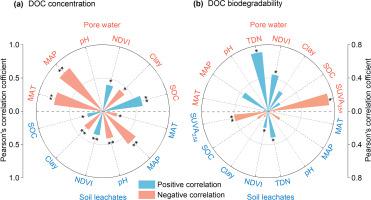Science of the Total Environment ( IF 8.2 ) Pub Date : 2020-09-16 , DOI: 10.1016/j.scitotenv.2020.142378 Futing Liu , Dong Wang , Beibei Zhang , Jin Huang

|
Dissolved organic carbon (DOC), as active and mobile carbon, plays a critical role in terrestrial and aquatic ecosystems. However, it remains unclear how the concentration and biodegradability of soil-derived DOC (extracted from pore water or soil leachates) vary over a global scale and what determines the variations in DOC concentration and biodegradability. Here we addressed this issue by synthesizing the dataset involved in 121 sites from 39 literatures worldwide, and analyzed the patterns and drivers of DOC concentration and biodegradability. Our results showed that the DOC concentration in either pore water or soil leachates varied considerably, with mean values of 33.2 mg L-1 in pore water and 213.5 mg kg-1 in soil leachates, respectively. Mean annual precipitation (MAP) was the dominant control on the variability in soil-derived DOC concentration. Our results also revealed that the biodegradability of DOC in pore water was significantly lower than that in soil leachates, with the means of 16.5% versus 28.7%, respectively. Specific UV absorbance (SUVA254, a parameter used for evaluating dissolved aromatic carbon content) was the primary indicator predicting the spatial variation in DOC biodegradability, whereas MAP exerted limited effects on DOC biodegradability. These results demonstrate the high biodegradability of soil-derived DOC, highlighting its crucial role in the global carbon cycle under climate change.
中文翻译:

来自土壤的溶解有机碳的浓度和生物降解性:全球视角
溶解性有机碳(DOC),作为活性碳和移动碳,在陆地和水生生态系统中起着至关重要的作用。但是,尚不清楚在全球范围内(从孔隙水或土壤渗滤液中提取的)土壤来源的DOC的浓度和生物降解性如何变化,以及由什么决定DOC浓度和生物降解性的变化。在这里,我们通过综合来自全球39个文献的121个站点中涉及的数据集来解决此问题,并分析了DOC浓度和生物降解性的模式和驱动因素。我们的结果表明,孔隙水或土壤渗滤液中的DOC浓度差异很大,孔隙水中的平均值分别为33.2 mg L -1和213.5 mg kg -1在土壤渗滤液中。平均年降水量(MAP)是土壤衍生DOC浓度变化的主要控制因素。我们的结果还表明,孔隙水中DOC的生物降解能力明显低于土壤渗滤液,分别为16.5%和28.7%。特定的紫外线吸收率(SUVA 254,用于评估溶解的芳族碳含量的参数)是预测DOC生物降解能力空间变化的主要指标,而MAP对DOC生物降解能力的作用有限。这些结果表明,土壤来源的DOC具有很高的生物降解性,突显了其在气候变化下全球碳循环中的关键作用。











































 京公网安备 11010802027423号
京公网安备 11010802027423号